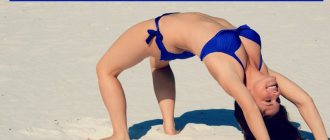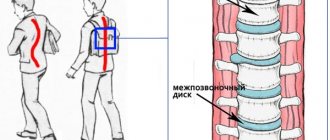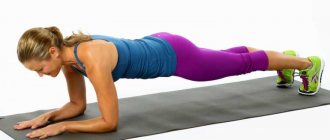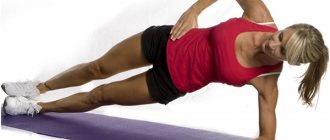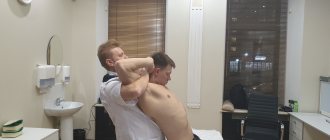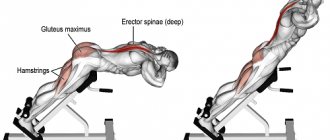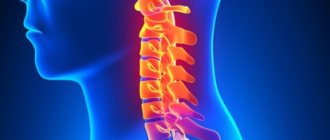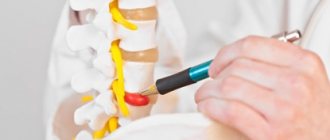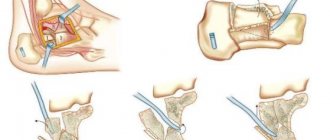We talked to a sports doctor.
Even if you are not the most athletic person, you have probably tried to pump up your abs. How to do the plank, because now it is recommended “from every iron.” One problem: these exercises can not only improve your fitness, but also cause serious harm - especially if you have back pain or a herniated disc.
We have already talked about the causes of back pain - to avoid them, you need to train stabilizer muscles. Now Alexander Kolesov, a sports medicine and physical therapy doctor at the MEDSI Clinical Diagnostic Center, talks about which exercises are suitable for this and which are harmful.
Plank exercise - how much to do, benefits and harms, technique
Crunches
For lower back pain, twisting and stretching exercises in the lumbar spine are often recommended. Surely everyone is familiar with the pose: you lie on the floor with your arms outstretched and your legs bent at the knees pressed to the floor on one side (photo below). This popular twisting technique is dangerous for the lumbar spine. Safe movement of the lumbar vertebrae is 5-10 degrees to the right or left. Accordingly, with excessive load, the facet joints are damaged and the pain syndrome intensifies.
How you can: you can twist in the middle and lower thoracic spine, that is, go from the upper half of the body, and not from the lower, and at this moment the pelvis needs to be fixed.
This is so wrong: movements from the pelvis injure the lumbar region.
This is correct: the pelvis is fixed, movements are in the thoracic region.
Ab crunches
Many people experience lower back pain during this exercise. “Because you lift it off the floor,” the coach usually says. But it’s very difficult not to tear it off, especially for an untrained person. Because during this exercise the main load is not on the abdominal muscles, but on the iliopsoas muscle, which is already in increased tone during back pain. As a result, overstrain develops in the intervertebral discs of the lumbar spine, which can aggravate the pain syndrome.
How you can: replace such crunches with isometric or eccentric exercises for the abdominal muscles.
Isometric exercises are static exercises, with position fixation. Here are three recommended exercises.
1. Lie down on the floor, knees bent, reach your hands to your knees, without lifting your body below the shoulder blades, and freeze for 10 seconds. Repeated 5-10 times with rest between them.
2. Kneel down, arms along the body, keep your back straight, smoothly bend back, fix the pose.
3. Lying on the floor, raise the straight left leg 30-45 degrees, pull the toe, bend the right leg and place the foot on the left knee; we raise the body without lifting the body below the shoulder blades, arms along the body; fix the pose for 10 seconds. Repeat 5-10 times with breaks.
Muscle contractions can be concentric (when the muscle shortens) or eccentric (the muscle lengthens). The most obvious example: when you bend your arm at the elbow with dumbbells, this is concentric tension, when you straighten it, it is eccentric.
For eccentric exercises, you can use an elastic band. It helps to fix the body parts and provides the necessary resistance during extension.
Example: lying on the floor, we fix the tape on the feet and hands, legs bent at the knees at an angle of 90 degrees, arms straightened above the shoulders. Slowly lower the left leg and at the same time the right arm, fix it, return it to its place, change the arm and leg.
Hyperextension and reverse hyperextension
This is an exercise in which you lift your body and/or legs off the floor or on a special apparatus. Its implementation leads to excessive tension in the lumbar spine, so it is not recommended for back pain and protrusions and hernias in the lumbar spine.
As possible: it is better to replace it with a straight and side plank in static mode, performing a series of 8 times for 20 seconds of holding.
Even the simplest exercises can be dangerous. And it is a mistake to think that if you go to yoga, which is recommended to improve your posture, then all the asanas there will be really useful to you. The trainer should warn that if the lower back is unstable, the exercise needs to be replaced, but this is not always the case. Therefore, if you have been bothered by back pain, you should find out the cause, get your doctor’s recommendations and adjust your subsequent workouts in accordance with them.
Why do you need to pump up your abs with lumbar osteochondrosis?
As you understand, in the subacute period we perform the simplest and easiest exercises, lying on our backs and with a flat pillow under our lower back.
Look at video examples of such exercises.
Do you think that in this case the press does not work?
It is due to his work that such therapeutic exercises are performed!
This is how we put the abs into work first - from the simplest exercises. An important condition is that for now we include such exercises only in the main part of the complex, alternating with other unloading exercises.
Usually 4-5 days are enough to move on to other therapeutic abdominal exercises. At this stage, we continue to do exercises in unloading positions, but not only lying on our backs, but also lying on our stomachs, standing on all fours.
How to properly complicate the load on the abs without overdoing it?
An example of abdominal exercises with increasing load: lifting both legs, bent at the knees and hip joints, first without the participation of the pelvis. Later we make it more difficult - we begin to raise the bent legs together with the pelvis.
At the same time, we engage the back muscles in the work, performing therapeutic exercises while lying on the stomach.
Here is an example of a mini-complex for the abs and back muscles at this stage.
Of course, do not forget about the warm-up and cool-down in order to properly prepare the body for work and properly relax it after completing the main complex.
Later you need to diversify the exercises, combine exercises for different corset muscle groups, using different starting positions. This way you will gradually strengthen all the core muscles.
Then the abs and strong back muscles will take on household loads and evenly distribute them among themselves, unloading the spine and keeping it healthy.
Such a scheme will be safe and at the same time effective.
It is according to this scheme that I built my step-by-step online program “Secrets of a healthy lower back”
All sets of exercises in the program are divided into four stages:
- The first stage - subacute period - all exercises only strictly lying on your back in combination with relaxation and breathing exercises
- The second stage – strengthening the anterior abdominal wall and “helpers” of the lumbar region – exercises for the transition period and preparation for the third stage
- The third stage is strengthening the muscle corset - exercises to work out all muscle groups of the corset. They are distributed so as not to create a large load on the lower back, but also gradually strengthen and restore it
- The fourth stage is stabilization of the spine - exercises in a standing position, bending over, balance exercises in combination with unloading exercises. Once you have strengthened and restored the balance between the large muscle groups, you can work on the small muscles that stabilize the spine.
At the moment there is a special discount for this program for my subscribers. You can get acquainted with its detailed description by clicking on the link below on the page and take advantage of the opportunity to purchase the program at a special price.
Click here to view the program description and take advantage of the discount
And another important condition!
It is very important to combine exercises for the abs and back muscles with unloading exercises. All exercises in the therapeutic complexes of the “Secrets of a Healthy Lower Back” program are combined with each other so as not to overload the muscles and at the same time the work is effective.
This concludes today's lesson. In the next lesson we will talk about the connection between incorrect posture and lumbar osteochondrosis. It will be interesting!
See you soon!
Hanging lateral leg raises
Grab the bar in a high position. Hands shoulder width apart. Inhale. As you exhale, raise your legs and simultaneously turn them in one direction. As we inhale, we return to our original state.
Do a series of lifts, turning your lower body first to one side, then to the other. During the exercise, do not swing your body so as not to help yourself lift with your legs due to inertia.
Crunches while sitting on a horizontal surface
Place yourself on the edge of a horizontal plane and grab it with your hands near your pelvis. Just lean back and lift your straightened legs. Bend and pull them towards your chest, while pulling your body towards your legs, that is, bending your chest down.
It turns out that the knees and chest part of the body move towards each other. In this state, the abdominal muscles are extremely compressed. As you inhale, return to the starting position.
Pain caused by injuries and diseases of the musculoskeletal system
Back pain occurs not only due to muscle overload with training load, but also due to swelling, which is a consequence of diseases and injuries. Pain limits movement and prevents careless activity. Pain is a protective reaction of the body, so attempts to continue working out the abs while overcoming back pain can lead to the development of the disease. If pain occurs, you should stop training and find out the cause of its occurrence, which may be due to injuries and pathologies.
This pain may be the result of:
- sprains;
- curvature of the spine;
- osteochondrosis;
- hernias
When a sprain occurs, pain from the lower back can radiate up and down the body. Turning and bending aggravate the pain syndrome. Muscles and ligaments are susceptible to this injury. Sprains are caused by weak abdominal and back muscles and insufficient physical warm-up during training.
Weak back and abdominal muscles can cause spinal curvature
Spinal curvature is another cause of pain during exercise. Weak abdominal muscles are one of the causes of spinal deformation and poor posture. This common pathology does not eliminate the need to strengthen the abdominal muscles, but requires caution during training. In this disease, the spinal discs experience uneven pressure, and joints are overloaded.
If a person with such problems decides to pump up the abs, then complications are likely: ordinary exercises of bending the torso and raising the legs will become stressful for the spinal discs, which experience additional pressure and stretching. Therefore, when strengthening the press, it is necessary to take into account the type of curvature of the spine and limit the range of movements. It is advisable to first strengthen the back muscles, and then begin to load the abdominal muscles. Otherwise, an increase in the amplitude and intensity of movements can lead to disc rupture and hernia. The contents of the spinal disc come out; the swelling begins to put pressure on the nerve endings, which causes pain.
Alternative Ab Exercises
There is another, simplest way to reduce back pain when you pump up your abs - replace the exercises with alternative ones that give a similar result, but put much less strain on the lower back and back muscles.
- lifting legs while hanging on the bar (bent or straight);
- squats with a straight back - a static exercise, you need to squat for 7-10 minutes as if you were sitting on an imaginary chair, move your pelvis back as far as possible, arms forward, back straight;
- bar on the arms, on the elbows and on the side, which we already wrote about above;
- lifting straight and/or bent legs in a lying position (place your hands under your lower back while performing the exercise);
- corner - lean on your straightened arms, sitting on the floor, lift your bent legs at an angle of 45 degrees to the floor, alternately bring them to your body and straighten one or both legs. At the same time, try to fix the body.
Lying leg raises are another way to pump up your abs without putting strain on your lower back.
How to pump up your abs in two weeks - advice is given by a guest of the “Everything Will Be Good” program - Sergey Konyushok (issue 533 of 02/23/2015).

